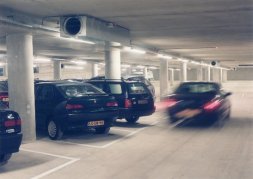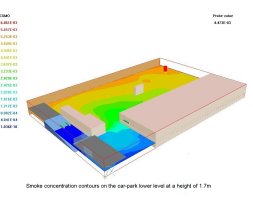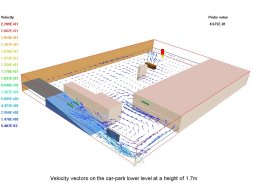Fire and smoke ventilation in an underground car park
 CFD is being used
increasingly to complement the engineering design of fire and smoke ventilation
systems required to meet fire safety regulations. The use of CFD to simulate
smoke removal during fires allows design strategies for ventilation to be
investigated for different scenarios before construction and installation. In
particular the response of key components of the smoke control system, such as
powered exhaust ventilation fans, ceiling-mounted jet fans and smoke curtains,
can be examined in terms of facilitating fire fighting operations and
maintaining clear escape and access routes.
CFD is being used
increasingly to complement the engineering design of fire and smoke ventilation
systems required to meet fire safety regulations. The use of CFD to simulate
smoke removal during fires allows design strategies for ventilation to be
investigated for different scenarios before construction and installation. In
particular the response of key components of the smoke control system, such as
powered exhaust ventilation fans, ceiling-mounted jet fans and smoke curtains,
can be examined in terms of facilitating fire fighting operations and
maintaining clear escape and access routes.
The CFD code PHOENICS 3.4 has been used by Rucon B.V.Ventilatoran to
investigate the performance of a fire-protection system in the event of a car
fire in an underground car park. The fire-protection system in the car park
comprises a smoke-exhaust ventilation system with a number of
strategically-placed jet fans that transport the air-smoke mixture towards the
extraction fans. The system is intended to ensure the safe escape of the
occupants from the various car-park levels by maintaining any smoke layer above
the heads of the people.
 The PHOENICS model
simulated two levels of the car park and included such details as
ceiling-mounted ventilators, extract fans, columns, dividing and external walls,
ramps and other internal structures. The task was to predict fire and smoke
movement in the underground car park for a number of ventilation designs.
PHOENICS was used to simulate a car fire on the lower level by means of a
time-dependent source of heat and smoke; thermal radiation was modelled by means
of the computationally efficient and pragmatic IMMERSOL model. The final design
for fire containment employed jet fans on the upper level to force air down
towards an extract fan located on the lower level.
The PHOENICS model
simulated two levels of the car park and included such details as
ceiling-mounted ventilators, extract fans, columns, dividing and external walls,
ramps and other internal structures. The task was to predict fire and smoke
movement in the underground car park for a number of ventilation designs.
PHOENICS was used to simulate a car fire on the lower level by means of a
time-dependent source of heat and smoke; thermal radiation was modelled by means
of the computationally efficient and pragmatic IMMERSOL model. The final design
for fire containment employed jet fans on the upper level to force air down
towards an extract fan located on the lower level.
The PHOENICS INFORM facility was employed to specify via the pre-processor a
smoke-dependent gas emissivity. In addition INFORM was used by Rucon to
introduce their own formulae for computing the volumetric smoke concentration
and estimates of the local visibility. The advantage of INFORM is that it
obviates the need for user FORTRAN and recompilation, and it also enables easy
and flexible interpretation of the solution fields in an engineering framework.
 The PHOENICS analysis
allowed optimisation and verification of Rucon's ventilation strategy. Rucon
commented "We have used CFD to prove that in the case of a car fire on the lower
level, smoke does not progress to the upper level by use of the right
ventilation system and strategy. The reason and the big advantage we have by
using PHOENICS, is the fact that we can predict the movement of air and smoke in
a car park before something is installed. We can make the airflow visible and
understandable."
The PHOENICS analysis
allowed optimisation and verification of Rucon's ventilation strategy. Rucon
commented "We have used CFD to prove that in the case of a car fire on the lower
level, smoke does not progress to the upper level by use of the right
ventilation system and strategy. The reason and the big advantage we have by
using PHOENICS, is the fact that we can predict the movement of air and smoke in
a car park before something is installed. We can make the airflow visible and
understandable."
 CFD is being used
increasingly to complement the engineering design of fire and smoke ventilation
systems required to meet fire safety regulations. The use of CFD to simulate
smoke removal during fires allows design strategies for ventilation to be
investigated for different scenarios before construction and installation. In
particular the response of key components of the smoke control system, such as
powered exhaust ventilation fans, ceiling-mounted jet fans and smoke curtains,
can be examined in terms of facilitating fire fighting operations and
maintaining clear escape and access routes.
CFD is being used
increasingly to complement the engineering design of fire and smoke ventilation
systems required to meet fire safety regulations. The use of CFD to simulate
smoke removal during fires allows design strategies for ventilation to be
investigated for different scenarios before construction and installation. In
particular the response of key components of the smoke control system, such as
powered exhaust ventilation fans, ceiling-mounted jet fans and smoke curtains,
can be examined in terms of facilitating fire fighting operations and
maintaining clear escape and access routes. 
